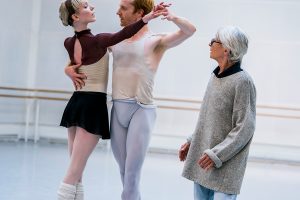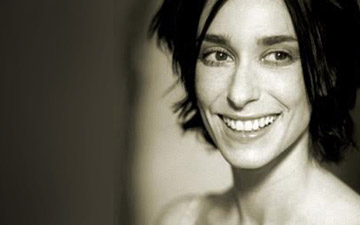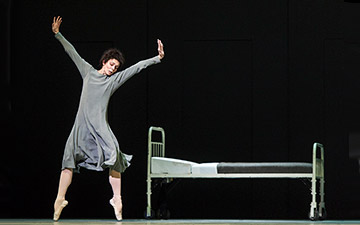
© Royal Opera House. (Click image for larger version)
Gary Harris has had one of the most varied ballet careers you can get… from dancer through to artistic director, but he is now widely known as a notator and for setting well-known ballets on major companies. Currently he’s working with the Royal Ballet to bring back Kenneth MacMillan’s Anastasia and Jann Parry went for a chat…
The Royal Ballet in Kenneth MacMillan’s Anastasia opens at London’s Royal Opera House on the 26 October 2016. Full Details
www.roh.org.uk
www.kennethmacmillan.com on Anastasia
Gary Harris, freelance ballet all-rounder, has been back at the Royal Ballet, mounting Kenneth MacMillan’s Anastasia for its latest revival, opening 26 October 2016. He’s been all over the world as a dancer, teacher, ballet master, artistic director, notator and designer. He’s happy with the way his varied career has worked out, unpredictable though it continues to be.

© ROH, 2016. Photographed by Tristram Kenton. (Click image for larger version)
‘It’s lovely to be able to work intensively, then take time to be at home with my dog’, he says. ‘I’ve taught Anastasia in Japan, Manon in Paris, Romeo and Juliet all over the place, and quite recently The Invitation for the Royal Ballet. I do mainly MacMillan ballets, along with Julie Lincoln, Karl Burnett and Patricia Ruanne. But I’ve also restaged Ashton ballets and worked with William Forsythe.’
His interest and skill in notation goes back to his days as a student in the Royal Ballet School, after his early training at Arts Educational. ‘I loved it – the whole graphic process which I’d enjoyed since I was a child. My mum worked for C&A Modes in London as a sketcher – she drew alterations for retail buyers who wanted to try out different ideas for clothes, a bow here or buttons on the other side – so she had pencils and paints to hand. My grandpa worked in a paper factory in Battersea, so I was always drawing on bits of paper.’ So was his brother, who became a goldsmith.
Their parents provided Gary with Pollocks model theatres, complete with lights installed by his electrician father. ‘I was inhabiting that theatre-design world from when I was little. Then, when I became a dancer with Festival Ballet, we’d be doing choreographic workshops and somebody would go, “Oh Gaz, could you knock us up a costume” and I was happy to oblige.”

© Royal Opera House. (Click image for larger version)
He left London Festival Ballet (now English National Ballet) in 1985 to pursue a career in the commercial theatre. ‘I was thinking of moving on just when the dance captain for On Your Toes told me to audition because they needed a classically trained dancer for the pas de deux. Natasha Makarova had left the show and Doreen Wells had taken over. When they asked me to sing at the audition, I was huddled in the wings, cringing. All these trained-up youngsters had prepared a song and all I could do was sing “Happy birthday”. I got the job and yes, I did sing along. I wasn’t scared to make a noise.’
While he was dancing in West End shows, Gary started teaching. ‘Maryon Lane asked me to take over her classes in Pineapple Studios while she took a break. Then Harold King was looking for a ballet master and let me loose on London City Ballet. It just snowballed from there as a seamless transition from performing.’
He was ballet master for Dance Advance, the small company formed of Ex-Royal Ballet dancers by Susie Crow and Jennifer Jackson, when he met Kenneth MacMillan in 1988. ‘He was doing Sea of Troubles for them, and I was fascinated by how he relied on a notator, Jane Elliott. So I decided to take a year out to do a Benesch notation course full-time. I’d only just completed the course when Kenneth asked me, along with Monica Parker and John Auld, to mount Manon for the Paris Opera Ballet. Talk about being thrown in at the deep end, with that company. I’ve been back since, several times, when they revive it.’
Garry Trinder, artistic director of the Hong Kong Ballet (1985-1991), offered him the job of ballet master and then associate director of the company for two years. Later, he became artistic director of the Royal New Zealand Ballet from 2001 to 2010. He restaged many of the classics for RNZB, sometimes serving as designer as well. He mounted his own productions of The Nutcracker and Don Quixote. ‘I enjoyed working with the wardrobe department and it saved money – I didn’t draw two salaries. After I’d left as director, I designed The Sleeping Beauty for them in Greg Horsman’s production, and then I did take the designer’s fee.’
Gary Harris and Viviana Durante rehearsing Natalia Osipova in Anastasia.
He left the company in good shape, artistically and financially, and came back to London as a base for new challenges. He has design commissions to prepare, as well as his freelance role as repetiteur and restager. Together with Deborah MacMillan, he is developing some adaptations to Anastasia that they tried out in Japan. Because the latest Royal Ballet production is to be a live relay in cinemas, the link between the first two acts and the third (originally made for the Deutsche Oper Ballet in 1967) is to be made clearer. ‘Now that we know Anna Anderson’s story about being Anastasia isn’t true, which Kenneth rather hoped it was, we’re presenting the first two acts as unreliable ‘memories’. She’s seen at the start watching home movies of the Romanov family, which prompt her fantasies. And then she sees the films again in Act III, when she’s in the asylum. We need the liberty to play with the time line – I wish we could do it even more, using film montages, but it’s tricky in an opera house.’
Gary always has the ‘bible’ – the notated score – to hand when he teaches the revival of a ballet. ‘I watch DVDs and old videos, crosschecking with the score, before I go into the room, so that I absorb as much as possible. But I rely on the score for details. It’s so nostalgic to see the names of the original cast for Anastasia [1971] in the margins. I saw it when I was a student, in the original Barry Kay designs. They disintegrated, so now we use Bob Crowley’s designs, which he’s changed a bit for this revival.’

© ROH, 2016. Photographed by Tristram Kenton. (Click image for larger version)
Does Gary think ballet students should learn to use notation as fluently as music students have to do? ‘Well, yes, it’s the inevitable question’, he says. ‘But I think dancers are so focused on being physical, on getting into the studio and dancing, that the other side gets overlooked. It’s asking a lot to have to sit down and learn these strange little symbols. I loved it, but nowadays dancers prefer looking at moving images on a phone or an i-pad, instantly available, instead of having to decode a written score.’
Learning notation has given Gary Harris yet another career, and the opportunity to travel and engage with ballet companies around the world. Right now, he’s off to get physical – taking Doris, his Bassett hound, for her walk.

















You must be logged in to post a comment.